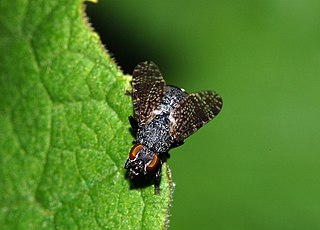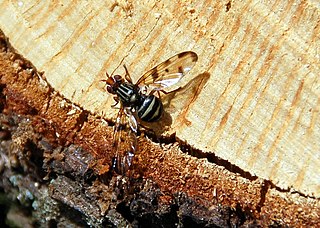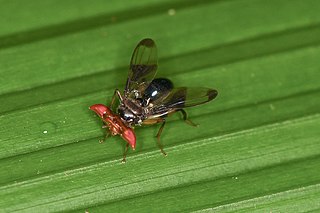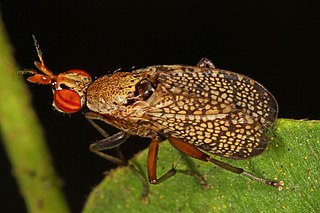
The family Sciomyzidae belongs to the typical flies (Brachycera) of the order Diptera. They are commonly called marsh flies, and in some cases snail-killing flies due to the food of their larvae.

The Ulidiidae or picture-winged flies are a large and diverse cosmopolitan family of flies (Diptera), and as in related families, most species are herbivorous or detritivorous. They are often known as picture-winged flies, along with members of other families in the superfamily Tephritoidea that have patterns of bands or spots on the wings. Some species share with the Tephritidae an unusual elongated posteroapical projection of the anal cell in the wing, but can be differentiated by the smoothly curving subcostal vein. Two species, Tetanops myopaeformis and Euxesta stigmatias, are agricultural pests.

The Micropezidae are a moderate-sized family of acalyptrate muscoid flies in the insect order Diptera, comprising about 500 species in about 50 genera and five subfamilies worldwide,. They are most diverse in tropical and subtropical habitats, especially in the Neotropical Region.

Xylomyidae is a family of flies known commonly as the wood soldier flies. They are xylophagous and are associated with dead or dying wood.

The Platystomatidae are a distinctive family of flies (Diptera) in the superfamily Tephritoidea.

Terellia is a genus of tephritid or fruit flies in the family Tephritidae.

Melieria is a genus of picture-winged fly in the family Ulidiidae.

Myennis is a genus of picture-winged flies in the family Ulidiidae.

Otitinae is the name of a subfamily of flies in the family Ulidiidae. It was formerly the Otitidae. Like the Ulidiinae, most species are herbivorous or saprophagous. Most species share with the Tephritidae an unusual elongated projection of the anal cell in the wing, but can be differentiated by the smoothly curving subcostal vein. Most are dull gray to shiny brown or black flies with vein R1 setulose or, in a few cases, bare.

Platystomatinae is a subfamily of flies (Diptera) in the family Platystomatidae that includes 80 genera, the largest subfamily with at last estimate, c. 900 species globally.

Pherbellia is a genus of flies in the family Sciomyzidae, the marsh flies or snail-killing flies. They occur throughout the world, except for the Subantarctic region.

Richardia is a genus of flies in the family Richardiidae. It was first described by French entomologist Jean-Baptiste Robineau-Desvoid in 1830. It occurs from Mexico to Central and South America.

Tetanocerini is a tribe of flies in the family Sciomyzidae. There are more than 400 described species in the tribe.

Tetanocera is a genus of marsh flies, insects in the family Sciomyzidae. There are at least 50 described species in Tetanocera.

Cordilura is a genus of dung flies in the family Scathophagidae. There are more than 90 described species in Cordilura.

Sciomyzinae is a subfamily of flies in the family Sciomyzidae.

Cephaliini is a tribe of picture-winged flies in the family Ulidiidae.
















